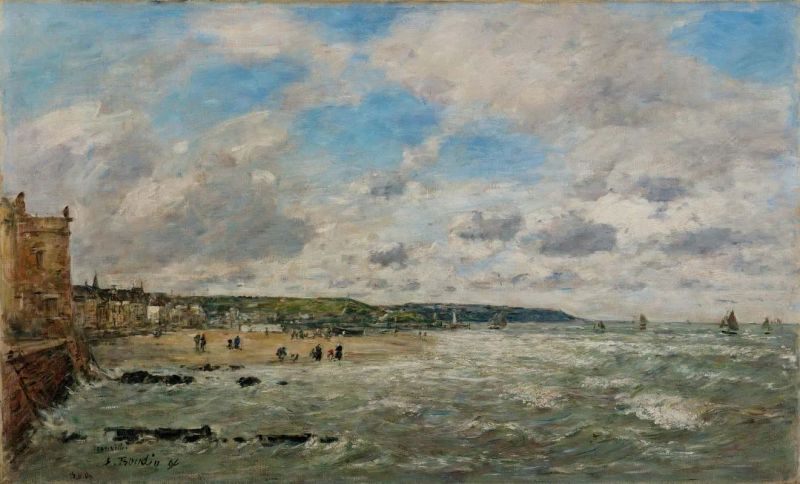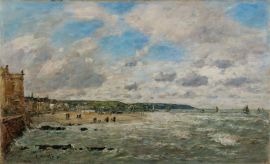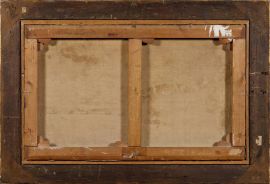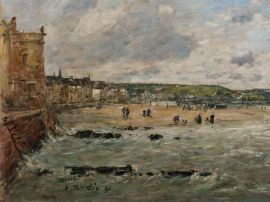Eugène Boudin
(Honfleur 1824 - Deauville 1898)
TROUVILLE, LE RIVAGE
oil on canvas, 55,5x92,5 cm
signed and dated "1896" lower left
Provenance
Gérard, Paris
Private collection
Exhibitions
Eugène Boudin 1824-1898, Kunsthalle, Brema, 23 settembre - 4 novembre 1979, n° 73, ill. a colori p. 75
Eugène Boudin 1824-1898, Galerie Schmit, Parigi, 7 maggio - 12 luglio 1980, n° 49, ill. a colori
Eugène Boudin 1824-1898, Knoedler & C°, New York, 10 novembre-12 dicembre 1981, n° 32, ill. a colori
Eugène Boudin 1824-1898, Galerie Schmit, Parigi, 10 maggio - 20 luglio 1984, n° 39, ill. a colori
Literature
R. Schmit, Eugène Boudin, Paris 1973, III, n° 3584, ill. p. 369
G. Jean-Aubry, Eugène Boudin, intr. e doc. di R. Schmit, Neuchâtel 1987, p. 229
The painting is included in the Schmit Archive with the number B-T.1897/383/3584.
We are grateful to Manuel Schmit for confirming the painting to be a work by Eugène Boudin.
It was Eugène Boudin, before Claude Monet, Camille Pissaro and Alfred Sisley, who was the first to challenge tradition, moving his easel from his studio out into the open air in the splendid landscapes of Normandy and Le Havre, following in the wake of the experience already explored by the School of Barbizon, where the main subjects were landscapes and country scenes populated by peasants and grazing animals.
Boudin is not inclined however, towards a realistic-romantic interpretation of landscape, but is enchanted by the constantly changing light effects, the wonders of nature, the countrysides and the beaches that come alive in his canvases.
Born in Honfleur, Normandy, in 1824, Boudin discovered his vocation as a painter late in life. After working as a sailor, he opened a frame shop that gave him the opportunity to meet many of the artists who frequented the area, such as Courbet and Corot. Later on, for the love of painting, he left everything to go to Paris, where, instead of studying at the Academy, he preferred to copy the great Venetian and Dutch masters at the Louvre.
He would return to Normandy whenever he could, moving from one beach to the other with his easel. He considered painting in the open air the only way to work: he was convinced that “two brush-strokes in contact with nature are worth more than two days of work in a studio”. Sometimes, during his painting excursions, he was accompanied by a much younger man, of whose qualities he was already well-aware: Claude Monet. They roamed together with their easel, trying to transfer onto the canvas those shimmering skies that, always changing, cast their reflections on the surface of the sea. In an age when the public preferred clear, well-defined painting, Boudin painted without defining the shapes: his palette grew lighter and fainter, making his works often look like sketches. The most important thing for him was to seize the exact moment when the reflection varied or the light changed colour, an aim he pursued throughout his life. In 1920 Claude Monet confessed to his biographer Gustave Geffroy that he owed all his success to Eugène Boudin, whom Corot had defined “the king of skies”. Through him Monet had learnt to read nature and to educate his eye; he recognized in him the gift of immediacy, a fundamental quality that always fascinated him. Boudin’s interest in nature and in the portrayal of landscape paved the way for the great Impressionist revolution.
Boudin exhibited for the first time at the Salon in Paris, with his work Le Pardon. In the summer of 1862 he painted his first beachside, a subject that, in its never-ending atmospheric variations, was to characterize his oeuvre. Over time, Boudin’s canvases kept to the same subjects, changing them according to the time of day: Plage aux environs de Trouville (1864) or Concert au casino de Deauville (1865) are examples of this group of works. Besides this genre, in the 1870s in particular, he also devoted himself to portraying the middle-class during their leisure time. The main locations of these works were the beaches and the new recreational facilities popular with the wealthy: the subject of these paintings is therefore, once again Normandy, where Boudin would spend half of the year, returning to Paris only for the winter. In December 1870 he moved to Bruxelles, summoned by the art dealer Gauchez, and worked there throughout 1871, also travelling to Antwerp, Bordeaux and the Netherlands, so as to vary his production. With the art market crisis in the middle of the 1870s, moving became more difficult; he started travelling again in the 1880s, until he moved into the house he had had built in Deauville, Lower Normandy: here the colours of his palette maintained a certain darkness, reflecting the weather of those northern lands. In 1874 he took part in the exhibition of the Impressionists in studio of Nadar. Several years later, in 1883, Paul Durand-Ruel, the first art dealer to understand the importance of Impressionists and a great admirer of Boudin’s work, dedicated a very successful exhibition to him in his new gallery in Boulevard de la Madeleine in Paris. Only in 1892, when for health reasons Boudin moved to the south, to the French Riviera, did his palette become lighter: he felt however incapable of translating the light of those lands and that sea into his painting. He will spend the following years between the French Riviera, Venice and Florence; he died in his beloved Deauville in August 1898.








